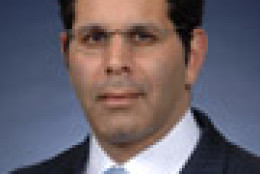National Institute of Standards and Technology
-
Rumors have been circulating over the last few months about a possible reconsideration of the identity management technologies agencies are implementing under Homeland Security Presidential Directive-12 (HSPD-12).
November 03, 2014 -
The National Institute of Standards and Technology has released its final version of the Cloud Computing Technology Roadmap. It incorporates more than 200 comments from government and industry, and it's intended to support the government's adoption of cloud computing. Bob Bohn is the Cloud Technical Program Manager at NIST. He joined Tom Temin on the Federal Drive with details on the roadmap.
October 29, 2014 -
You might be a dog on the Internet, but nobody can tell for sure. Confidence in who people say they are online is vital to a cyber secure future for government and industry. People at the National Strategy for Trusted Identities in Cyberspace have been working on this problem within the Commerce Department for a couple of years now. Jeremy Grant is senior executive advisor for Identity Management at the National Institute of Standards and Technology. He joined Tom Temin on the Federal Drive to discuss some recent progress.
October 20, 2014 -
It seems like the whole world is going mobile, and that includes the federal government. Agencies are using more and more apps for collaboration and productivity. But some apps increase the potential for exposing government data. To help you guard against these security risks, the National Institute of Standards and Technology is providing tips to the federal community for vetting third-party apps. Computer Scientist, Tom Karygiannis, joined Tom Temin on the Federal Drive to discuss the guidelines.
August 28, 2014 -
The National Institute of Standards and Technology kicks off the Global City Teams Challenge in September. Tech-savvy members from the federal government and private sector will come together to address issues including air quality, traffic management and emergency services coordination, all through the use of smart technology. Sokwoo Rhee, associate director for Internet of Things and Cyber-Physical Systems at NIST, joined Tom Temin on the Federal Drive to discuss what the agency hopes to accomplish.
August 26, 2014 -
A savings of $2 million per year is now being realized at the U.S. Mint after an innovative engineer stepped out of the box and asked a friend at another federal agency for help. In part three of our special report, Rainmakers and Money Savers, Federal News Radio takes you inside the lab where a group of engineers and nanotribologists combined their expertise to solve a coin-making problem and, in turn, saved a lot of cash.
August 14, 2014 -
The National Information Assurance Partnership, the U.S. implementation of what was supposed to be a faster, cheaper process to verify the cybersecurity of commercial IT products, turned out to be so slow and expensive that few companies could afford to go through it. But officials said they hope a recent overhaul in the procedures will breathe new life into the program.
July 02, 2014 -
It keeps getting easier to manufacture a counterfeit computer chip. Experts say federal information systems increasingly are at risk because of flaws in their supply chains. It is not just a question of fake parts. Genuine ones that have been tampered with, or are just poorly made, can cause damage. The National Institute of Standards and Technology is revising guidelines for agencies to help them secure their supply chains. Jon Boyens is an IT specialist in the security outreach and integration group at NIST. He spoke with Emily Kopp on the Federal Drive.
June 10, 2014 -
The National Institute of Standards and Technology has launched a four-part plan to help agencies build more secure IT systems. NIST Computer Scientist Ron Ross, who guided a new publication on the issue, tells the Federal Drive with Tom Temin and Emily Kopp that the same engineering principles that apply to bridges and buildings should apply to IT. That is, security should be built in, not added later.
May 15, 2014 -
Homes and buildings aren't built the way they used to be, and when they catch fire, they don't burn the same way either. Newer buildings have more open floor plans and much more use of plastics and synthetic materials. Now the National Institute of Standards and Technology and the Underwriters Laboratory have teamed up to educate firefighters on the modern fire. The course is based on a series of controlled burn experiments, performed with the help of the New York City Fire Department. Daniel Madrzykowski, a fire protection engineer and leader of the Fire Fighting Technology Group at NIST, told Federal Drive hosts Tom Temin and Emily Kopp what firefighters learn through the course.
April 29, 2014 -
Federal officials say they need help from Congress to ensure companies are protected under the law for sharing cyber information with the government. Officials also say building up the cyber workforce is a top concern.
March 27, 2014 -
The National Institute of Standards and Technology brought agency and industry experts to its Gaithersburg headquarters to discuss cloud computing this week. Federal News Radio's Lauren Larson was there. She spoke with NIST Cloud Technical Program Manager Robert Bohn about the key word of the event — interoperability. Read Lauren's related story.
March 25, 2014 -
The White House will release an updated list of agency high-priority goals and cross-agency priority goals with the annual budget request to Congress in March. Meanwhile, the Office of Management and Budget detailed agency successes over the last two years in meeting current goals.
February 14, 2014 -
On this week's Capital Impact show, executives from Liberty Group Ventures discuss the roll out of the administration's new cyber framework and how it will affect the private sector. February 13, 2014.
February 13, 2014 -
The Senate confirmed Sloan Gibson to be the next deputy secretary of the Department of Veterans Affairs. The director of the National Institute of Standards and Technology, Patrick Gallagher, is heading off to academia.
February 13, 2014










